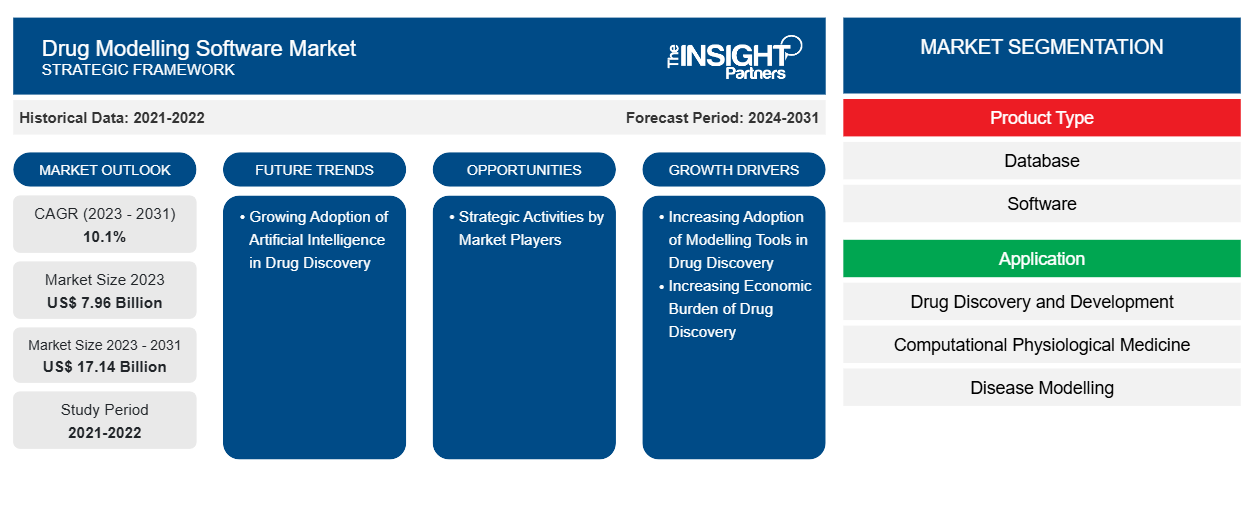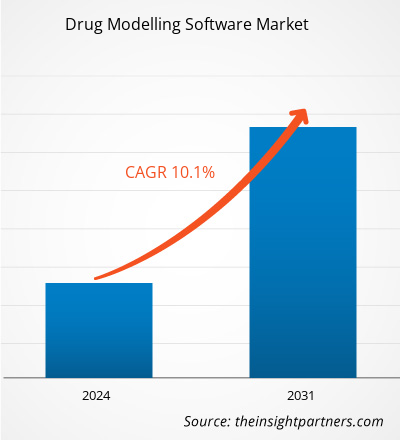The Drug Modelling Software Market size is projected to reach US$ 17.14 billion by 2031 from US$ 7.96 billion in 2023. The market is expected to register a CAGR of 10.1% in 2023–2031.The increased adoption of advanced technology such as artificial intelligence in drug discovery software are likely to remain key Drug Modelling Software Market trends.
Drug Modelling Software Market Analysis
There has been constant increase in the prevalence of chronic conditions such as cardiovascular disorders, cancer, neurological conditions, and others which has created the demand novel drugs for treatment of such conditions. The increase in research activities by pharmaceutical manufacturers and CROs for the development of novel drugs has increased the adoption of drug modelling software to enhance the overall drug discovery process. Moreover, surge in partnerships and collaborations among pharmaceutical manufacturers and software developers are also expected to expedite the entire process and contribute to the drug modelling software.
Drug Modelling Software Market Overview
Drug discovery is one of the complex, expensive and time consuming process and the developers are constantly under pressure because there is always scope for drug failure at any point of the entire process. The entire drug development takes approximately 10-15 years for the completion and commercialization of the developed drug. This entire process requires resources such as capital, trained professionals, and machinery. Most of the pharmaceutical companies outsource such services which only requires huge capital. Moreover, increase in automation has further led to increased used of software to simplify some of the works which is time saving. Furthermore, increase in contract research organizations and prevalence of various chronic conditions fuelled the drug development activities which in turn increases the deployment of drug modelling software contributing to the market growth.
Customize This Report To Suit Your Requirement
You will get customization on any report - free of charge - including parts of this report, or country-level analysis, Excel Data pack, as well as avail great offers and discounts for start-ups & universities
Drug Modelling Software Market: Strategic Insights

-
Get Top Key Market Trends of this report.This FREE sample will include data analysis, ranging from market trends to estimates and forecasts.
Drug Modelling Software Market Drivers and Opportunities
Increasing Economic Burden of Drug Discovery to Favor Market
In the last few years, several computational tools have been developed for the identification, selection, and optimization of pharmacological lead candidates. Currently, there are several computational approaches available for the drug discovery process. The predictive power of these tools has been proven to be very advantageous, allowing researchers to bypass the screening of billions of molecules. As a result, computational services, such as quantitative structure-activity relationship (QSAR), modelling, and computer-aided drug design (CADD), have now become an integral part of the pharmaceutical industry. Moreover, pharmaceutical companies that are focused on the development of large molecules are likely to continue outsourcing their respective drug discovery and development operations from drug Modelling providers.
Strategic Activities by Market Players– An Opportunity for Drug Modelling Software Market
The companies engaged in drug discovery and development are adopting various business strategies to expedite discovery timelines and improved product success. The future of drug discovery relies on the collaboration among innovative biotech companies, academics, and pharma. Moreover, several players involved in this space are continuously expanding their capabilities to enhance their respective in silico-based service portfolio and maintain a competitive edge in the industry. A lot of pharmaceutical companies have been benefited by adopting these technologies, which, in turn is expected to propel the growth of the drug Modelling software during the forecast period. For instance, in march 2022, Acellera and Chemotargets collaborate to offer drug discovery and development services and to advance a common internal pipeline of drug development projects.
Drug Modelling Software Market Report Segmentation Analysis
Key segments that contributed to the derivation of the Drug Modelling Software Market analysis are product type and application.
- Based on product type, the Drug Modelling Software Market is segmented into database, software, and others. The software segment held a larger market share in 2023.
- In terms of application, the market is classified into drug discovery and development, medical imaging, computational physiological medicine, predictive analysis of drug targets, disease Modelling, simulation software, cellular simulation and others. The drug discovery and development segment dominated the market in 2023.
Drug Modelling Software Market Share Analysis by Geography
The geographic scope of the Drug Modelling Software Market report is mainly divided into five regions: North America, Asia Pacific, Europe, Middle East & Africa, and South & Central America.
North America has dominated the Drug Modelling Software Market owing to the Rapidly integration of artificial intelligence (AI) technology in the drug discovery, increasing preference for personalized medicine, high R&D spending and sophisticated infrastructure are some of the prominent factors propelling the market growth. In North America, the US is the largest market for drug Modelling software driven by the rapid integration of AI for the drug discovery, increasing preference for personalized medicine, high R&D spending for novel therapeutic applications and presence of major market players in the US. In addition to this, rising collaboration and partnerships among pharmaceutical companies with the artificial intelligence technology companies for the development of the drugs, further boosting the growth of the market. Furthermore, growing awareness about the artificial intelligence technologies in the pharmaceutical industries of the developing region, further proving the various growth opportunities in the market. Asia Pacific is anticipated to grow with the highest CAGR in the coming years.
Drug Modelling Software Market Regional Insights
The regional trends and factors influencing the Drug Modelling Software Market throughout the forecast period have been thoroughly explained by the analysts at The Insight Partners. This section also discusses Drug Modelling Software Market segments and geography across North America, Europe, Asia Pacific, Middle East and Africa, and South and Central America.
Drug Modelling Software Market Report Scope
| Report Attribute | Details |
|---|---|
| Market size in 2023 | US$ 7.96 Billion |
| Market Size by 2031 | US$ 17.14 Billion |
| Global CAGR (2023 - 2031) | 10.1% |
| Historical Data | 2021-2022 |
| Forecast period | 2024-2031 |
| Segments Covered |
By Product Type
|
| Regions and Countries Covered |
North America
|
| Market leaders and key company profiles |
|
Drug Modelling Software Market Players Density: Understanding Its Impact on Business Dynamics
The Drug Modelling Software Market is growing rapidly, driven by increasing end-user demand due to factors such as evolving consumer preferences, technological advancements, and greater awareness of the product's benefits. As demand rises, businesses are expanding their offerings, innovating to meet consumer needs, and capitalizing on emerging trends, which further fuels market growth.

- Get the Drug Modelling Software Market top key players overview
Drug Modelling Software Market News and Recent Developments
The Drug Modelling Software Market is evaluated by gathering qualitative and quantitative data post primary and secondary research, which includes important corporate publications, association data, and databases. The following is a list of developments in the market for drug modelling software and strategies:
- The company launched more than two dozen new microservices that allow healthcare enterprises worldwide to take advantage of the latest advances in generative AI from anywhere and on any cloud. The company has accelerated software development kits and tools, including Parabricks, MONAI, NeMo, Riva and Metropolis, can now be accessed as NVIDIA CUDA-X microservices to accelerate healthcare workflows for drug discovery, medical imaging and genomics analysis. (Source: NVIDIA Healthcare, Newsletter, 2024)
- The company launched its Biodrug Design Accelerator, a platform to manage research processes for peptide drug discovery, which many regard as a promising frontier in the field of new drug development. (Source: Fujitsu Limited, Company Website, 2023)
- The company launched its AIDDISON drug discovery software, the first software-as-a-service platform that bridges the gap between virtual molecule design and real-world manufacturability through Synthia retrosynthesis software application programing interface (API) integration. It combines generative AI, machine learning and computer-aided drug-design to speed up drug development. (Source: MilliporeSigma, Newsletter, 2023)
Drug Modelling Software Market Report Coverage and Deliverables
The “Drug Modelling Software Market Size and Forecast (2021–2031)” report provides a detailed analysis of the market covering below areas:
- Market size and forecast at global, regional, and country levels for all the key market segments covered under the scope
- Market dynamics such as drivers, restraints, and key opportunities
- Key future trends
- Detailed PEST/Porter’s Five Forces and SWOT analysis
- Global and regional market analysis covering key market trends, major players, regulations, and recent market developments
- Industry landscape and competition analysis covering market concentration, heat map analysis, prominent players, and recent developments
- Detailed company profiles
- Historical Analysis (2 Years), Base Year, Forecast (7 Years) with CAGR
- PEST and SWOT Analysis
- Market Size Value / Volume - Global, Regional, Country
- Industry and Competitive Landscape
- Excel Dataset
Recent Reports
Related Reports
Testimonials
Reason to Buy
- Informed Decision-Making
- Understanding Market Dynamics
- Competitive Analysis
- Identifying Emerging Markets
- Customer Insights
- Market Forecasts
- Risk Mitigation
- Boosting Operational Efficiency
- Strategic Planning
- Investment Justification
- Tracking Industry Innovations
- Aligning with Regulatory Trends





















 Get Free Sample For
Get Free Sample For